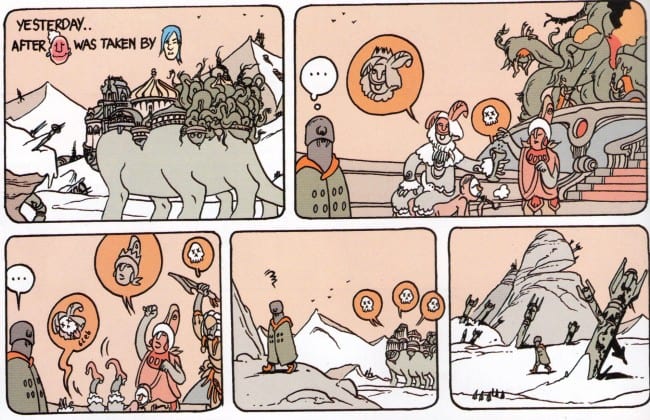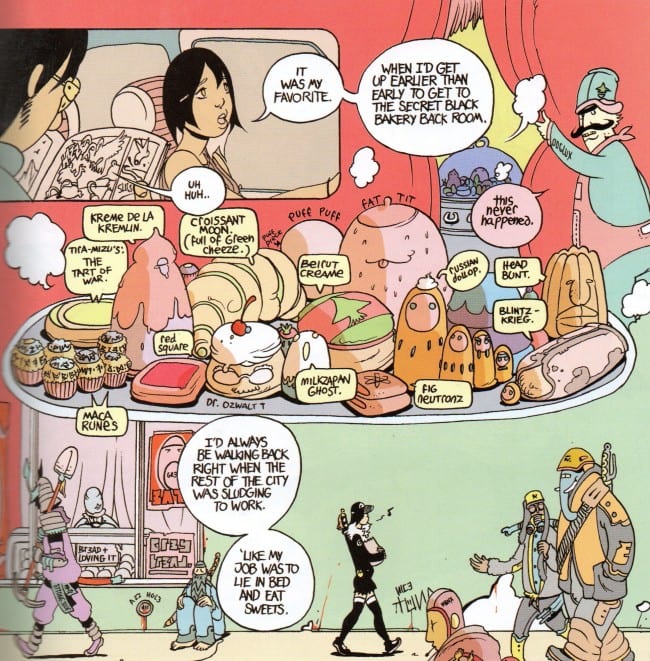This is not a long-gestating passion project that took years to see to its envisioned-from-the-outset conclusion, but a collection of comics drawn over the course of a decade, as the ongoing and evolving concern of an artist operating in a shifting commercial landscape, as an itinerant comics professional, going where there is work to be had. The scope grows along with the page count he is given to work with.
In the early 2000s, Brandon Graham was drawing pornography. At the time, this was considered a surefire moneymaker, and a space where his most apparent influence—the translated manga published by Studio Proteus in the late 1980s and early 1990s that was presented as roughly interchangeable with the works of American creators such as Adam Warren—was not considered a detriment. With permission granted to do whatever he liked, as long as there was sex in it, he produced the earliest story here, in which a female organ smuggler sneaks a werewolf penis inside her asshole to sew onto her boyfriend for his birthday. There are drawings of rectal insertion and buttholes dripping with lube. Looking back on the era when this comic was made, I recall it as a time where the manga style seemed unappealing specifically because of its association with perverts. In the context of pornography, however, Brandon can give shout-outs to such trashy-seeming comics as Joseph Wight's Antarctic Press title Twilight X, by having the boyfriend character, Nikoli, read an issue. It scans as a tribute, just one cartoonist talking about how much another's work means to him.

The follow-up story, done for an anthology that didn't require him to include sex, concerns the boyfriend going on a journey to deal with the werewolf dreams that have resulted from his amateur surgery, as the woman worries at home. This piece, I believe, originally ran in an anthology put together by the Meathaus collective, a group of artists who met in New York City while many were attending the School Of Visual Arts.
While Brandon did not attend the School Of Visual Arts, it is perhaps notable that the instructors there with the most avant-garde associations, David Mazzucchelli and Gary Panter, had previously found favor with Japanese audiences, and had been hired to do work for the Japanese market. Maybe this points towards explaining how a group of their students would have the insight to trust Graham to produce alternative comics, and not get tangled up in surface signals the way many people might. Here the influences Brandon cites with in-panel tips of the hat are experimental Tom Herpich and Matt Howarth, going a little deeper past visual cues. Meanwhile, the story puts into practice a belief Graham has that comics are better when you see characters eating and going to the bathroom, that there is a certain type of realism you communicate when dealing with such basic mechanisms of being alive.

After this point, chronologically, we move to the story that kicks off the collection, the first that ran as its own self-contained comic, where it is revealed that the series takes place in a science-fiction or fantasy version of Russia. Here the title "Multiple Warheads" - which, for all intents and purposes, was initially arrived at as a dick joke- becomes a header under which he can place anything he wants, functioning the same way “Love and Rockets” does for the Hernandez Brothers. It is a space where he can examine his concerns as a cartoonist and as a human being. Now that he is no longer drawing pornography, there is an increased awareness that some of his audience is female. You get to see him confront himself, the developments in his work that commercial concerns brought him to previously, as he works to develop the character of a female figure he named Sexica back when it didn't matter at all.
One reason Graham's Americanized manga style became more acceptable to a general audience, women and men beyond the market of people that regularly buy porn comics, was the explosion of books released to the American market by Tokyopop that found a large audience of young women in the bookstore market. When Tokyopop attempted to get into producing original English-language manga, Brandon was one of the North Americans hired. Separating the earliest pages collected in Multiple Warheads from the latest is a 400-page graphic novel's worth of artistic growth. The first 200 pages of that work, King City, appeared in a volume put out by Tokyopop, at digest-size dimensions that were readable but didn't really flatter the grace of Brandon's linework. Meanwhile, fashions had changed since the Studio Proteus days, and Tokyopop's hiring of North Americans to create work that read from left to right was viewed as inauthentic and unappealing to the market they'd made. The line was viewed as a failure economically, and plans for the sequel to come out through Tokyopop were squelched.

The work was enough of an artistic success to find admirers at Image Comics, who acquired publishing rights and printed the completed work, serialized in magazines, at a size that let the art breathe. The second half of King City has a focus and clarity to it that speaks to a leveling-up. The difference between selling 200 pages of comics for ten dollars and selling 32 pages for three dollars means that each page's worth of storytelling costs more money to the consumer, and consequently, Graham makes each page count more, and this brings again to the fore his love of the joke, the formalist trick, the page as a unit of comics rather than as a measurement of storytelling time.
The bulk of what makes up this collection originally appeared in the miniseries format, the same parameters of four issues that Adam Warren would've worked with drawing The Dirty Pair. This format rewards a very different approach to pacing, of considering the weight of how much story a page has to tell, than producers of manga in Japan usually have to work with. Here, also, he is given the opportunity to work in color, which allows both for another set of formal tricks and for Graham to stop spotting his blacks so much. With all the work collected here on the same glossy paper, the earlier pages' black ink catches the eye with the gleaming sheen of paint markers. With cleaner lines and a brightly colored palette, the drawings almost seem sculpted from bubblegum.

The miniseries retains the sense of the short stories that introduced these characters by breaking every issue into chapters. Nikoli and Sexica become a thread running in parallel to the story of another organ smuggler, mentioned off-hand previously, and as these characters make their travels, other figures introduced are shown living their lives, even when their connection to the ostensible main characters is merely cohabiting within the same hotel. Their story is a road narrative, and the presence of these other characters just serves to reinforce the notion that the journey is more important than any destination. The focus is on the individual moment, and each scene plays out as an interlude, an act of emphasis on some atmosphere or another. There are many different types of silences here, instructing a reader to slow down and focus on one element or another. Certain of these sequences play out as formal exercises where word balloons are used to contain glyphs instead of words, almost as inset panels. These require the reader to focus on image as a method of conveying information more studiously.
This approach to tonal shifts is approached in the one-shot, where sex scenes and dream sequences each take on a distinctive character of languor, absent the voice provided by narrative captions. That sex scene plays out differently than those he'd drawn years before. In the comics charged with the duty of being pornographic, he worked to fit in as many jokes inside that framework as he could. Later, having established sex explicitly as a part of the characters' relationship, he plays it much quieter, pausing on touch and the anatomy of bodies undressing rather than fast-forwarding to cum shots punctuated with graffiti-lettered sound effects.
In other scenes, the narration works to relay the science-fiction ideas and worldbuilding, which, while they may be of interest to Graham as a writer, would be difficult for him to convey visually. The grander the scope of the idea, the more easily it falls into the background. It is mentioned there are spaceships filled with people gone to fight a war with wolves; they explode in the atmosphere. What's foregrounded, as the thread of a larger narrative is either lost or ignored, is not specifically sex, but being in love, driving around, taking in the sights, taking in meals. It's a book about moving forward in time, moving through space, being a body. There are action sequences that focus on movement, orientations of people getting decapitated, where dead bodies and the recognizability of faces are used as markers to orient the characters, as they jump on top of cars stuck in traffic. There are also two-page spreads of fantastical landscapes, wide vistas. These emphasized aspects, of the sensory input of places, moving through them, is highlighted both as a pleasure of comics and as a pleasure of being alive. This approach lowers the stakes in terms of storytelling drama in order to more straightforwardly just be a comic that exists for the sake of sensory pleasure.

Food reoccurs in characters' conversation, and meals are detailed in panels with the food names all labeled, almost always with puns. The pleasure of a meal cannot be translated through the comics medium, but the pleasure of a joke can. This emphasis on food is something of a staple in fantasy literature: I recall being given a copy of The Hobbit in middle school, and putting it down after an early chapter's drawn-out description of a meal left me convinced that it was a book intended for the overweight. It is these textures of style that are chosen over the machinations of plot that bring you into the world.
The disinterest in having protagonists that serve as active participants in the major events of the book's world parallels Brandon's own status on the periphery of the events that have shifted in the comic book market to bring him to a place where he can create a monthly miniseries for a major publisher. At the same time, it is this approach which marks him as an outlier from the comics mainstream, simply because he cares more about what a comic is and what it can be than the stories that can be conveyed. I find this a refreshing approach, and while I do not think the book wants for narrative, that this collection does not conclude, nor does it climax, unless you count the original pornographic short included at the end almost as an afterthought, could be disappointing to readers less fascinated by cartooning as a vocation, and its practitioners sense of play.







